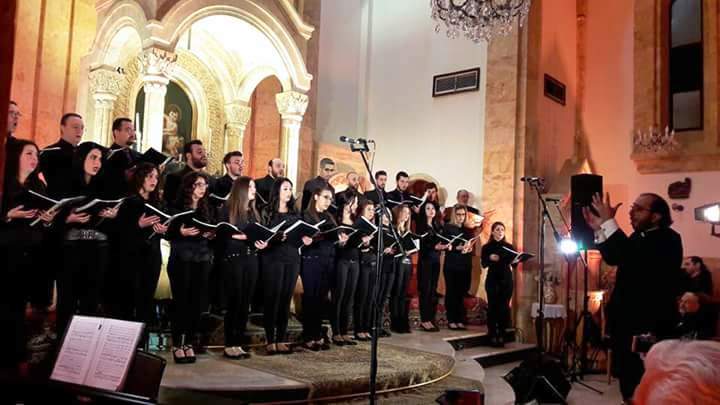
Dec 6, 2016 | Non categorizzato
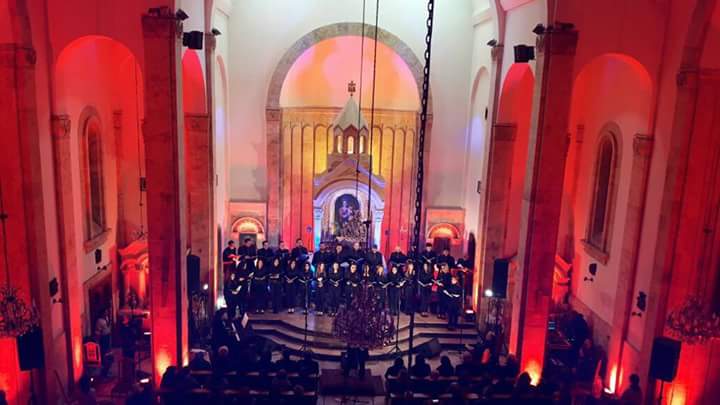 I attended for the first time, a classical music concert in the midst of a battle. It happened in Aleppo, where, surrounded by death, a voice of peace arose among many others that announced war, to comfort the hearts of the people and make them momentarily forget the cold and death. It was like a chapter of a modern tragedy that resembled Greek mythology. In a fully packed Church and with very few tools, Father Elias Janji with the Naregatsi choir and the pianist played some pieces of Verdi, Mozart, Vivaldi and Karl Orf, elevating our spirits to another horizon, despite the polar chill that has invaded Aleppo these days.. And to think that not too far away, the tragedy continues with missiles launched from Eastern Aleppo over the Western zone, killing school children and innocent people, while in the Eastern part of the city, the Syrian army continues to attack. Thousands of people (an estimated 60,000 up to today) managed to escape from East Aleppo and take refuge in the Western zone. They tell of how many have been taken as hostages and that some of those who were shot in their backs while escaping, were killed. Others escaped amid the gunfire, carrying their grandmas or other elderly relatives on their shoulders. The people were relieved since they could finally return to their own homes that were liberated in these days while the army took hold of the city’s water pumping station, even if it was mined. Water is forecasted to return to the city in a month’s time, after the technicians have completed their work. Thus a chapter of the tragedy will end, though there will surely be many more.
I attended for the first time, a classical music concert in the midst of a battle. It happened in Aleppo, where, surrounded by death, a voice of peace arose among many others that announced war, to comfort the hearts of the people and make them momentarily forget the cold and death. It was like a chapter of a modern tragedy that resembled Greek mythology. In a fully packed Church and with very few tools, Father Elias Janji with the Naregatsi choir and the pianist played some pieces of Verdi, Mozart, Vivaldi and Karl Orf, elevating our spirits to another horizon, despite the polar chill that has invaded Aleppo these days.. And to think that not too far away, the tragedy continues with missiles launched from Eastern Aleppo over the Western zone, killing school children and innocent people, while in the Eastern part of the city, the Syrian army continues to attack. Thousands of people (an estimated 60,000 up to today) managed to escape from East Aleppo and take refuge in the Western zone. They tell of how many have been taken as hostages and that some of those who were shot in their backs while escaping, were killed. Others escaped amid the gunfire, carrying their grandmas or other elderly relatives on their shoulders. The people were relieved since they could finally return to their own homes that were liberated in these days while the army took hold of the city’s water pumping station, even if it was mined. Water is forecasted to return to the city in a month’s time, after the technicians have completed their work. Thus a chapter of the tragedy will end, though there will surely be many more.  December 4 is the feast of St. Barbara, the young girl martyred in the first centuries of Christianity, pierced with a sword by her father since, as a follower of Jesus, she had refused to adore another God. It is a great feast for the Christians of the East, adults and children who, despite the war, gathered together to honour her in a masquerade and recount her story in song – a story which despite the centuries passed – has not changed very much. We can’t help but wonder, what has remained of man and his dignity? What will happen now? Will the war in Aleppo end, and bring back serenity to the people who have suffered so much, even if they will find a great part of the city destroyed? The population is weary and wants the conflict to end. But the armed groups refuse to accept defeat and want to fight to the last, despite the appeal of the UN special envoy, Staffan De Mistura, to all the groups to leave the city and spare the lives of the people, who would otherwise pay a heavy price, according to the logic of war! How can we forget that in the end, it is Man since each one, whether good or bad, is an image of God, though this image is buried under a thousand vices and wickedness. With Christmas now at our doorstep, let us therefore remind ourselves that this feast should not only be a remembrance of a past fact celebrated with the usual festivity. The arrival of the “Prince of Peace” should also change the hearts and gestures of all of us, because these become tiny stones in the construction of a better world we all dream of. From Aleppo, Pascal Bedros
December 4 is the feast of St. Barbara, the young girl martyred in the first centuries of Christianity, pierced with a sword by her father since, as a follower of Jesus, she had refused to adore another God. It is a great feast for the Christians of the East, adults and children who, despite the war, gathered together to honour her in a masquerade and recount her story in song – a story which despite the centuries passed – has not changed very much. We can’t help but wonder, what has remained of man and his dignity? What will happen now? Will the war in Aleppo end, and bring back serenity to the people who have suffered so much, even if they will find a great part of the city destroyed? The population is weary and wants the conflict to end. But the armed groups refuse to accept defeat and want to fight to the last, despite the appeal of the UN special envoy, Staffan De Mistura, to all the groups to leave the city and spare the lives of the people, who would otherwise pay a heavy price, according to the logic of war! How can we forget that in the end, it is Man since each one, whether good or bad, is an image of God, though this image is buried under a thousand vices and wickedness. With Christmas now at our doorstep, let us therefore remind ourselves that this feast should not only be a remembrance of a past fact celebrated with the usual festivity. The arrival of the “Prince of Peace” should also change the hearts and gestures of all of us, because these become tiny stones in the construction of a better world we all dream of. From Aleppo, Pascal Bedros
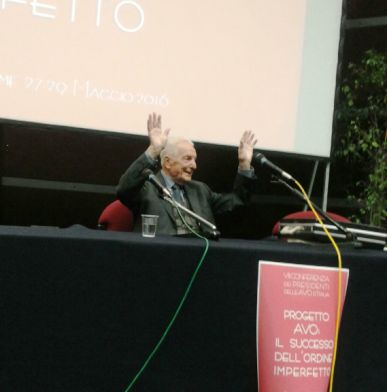
Dec 5, 2016 | Focolare Worldwide, Senza categoria
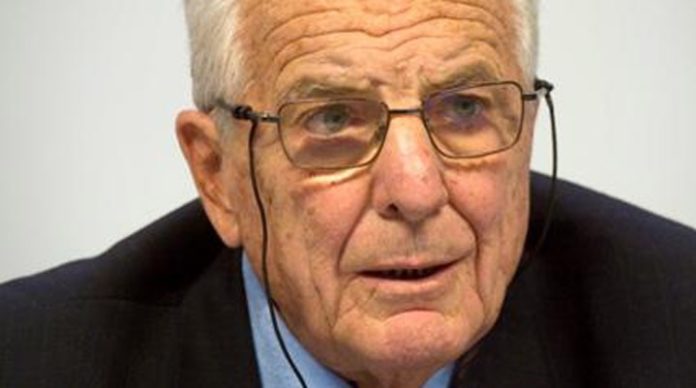 Erminio Longhini was born in Milan, Italy, on July 19, 1928. After his marriage with Nuccia, he and his wife had three children: Michela, Matteo and Stefano. While they were still university students, Nuccia and Erminio were determined to keep the human person at the centre of their professional life. “Ever since I was a child,” Erminio himself admits, “I felt strongly drawn to the Virgin Mary.” Perhaps this explains his filial devotion to “so beautiful a Mother” that even though he was buried in professional responsibilities, he offered to accompany the sick on their journeys to Lourdes. He was serious, scrupulous, demanding and went through years of hard sacrifice working from morning until deep into the night serving the sick and doing research. But his soul was also searching. He and Nuccia felt the need for a spirituality that could accompany the life of their family. They found their answer in the Focolare, in God-Love to whom Erminio felt called to give himself completely, and to serve all the brothers and sisters he would meet. He became a married focolarino. Thanks to generous contributions he set up an internal medicine department with modern equipment and welcomed young graduates from Italy and developing countries. He managed to engage colleagues and nurses until the medical division he directed became one of the best in both technical quality and in human relationships, with hundreds of published research projects. Erminio understood more and more that it was not enough to care for the patient, but for the human being.
Erminio Longhini was born in Milan, Italy, on July 19, 1928. After his marriage with Nuccia, he and his wife had three children: Michela, Matteo and Stefano. While they were still university students, Nuccia and Erminio were determined to keep the human person at the centre of their professional life. “Ever since I was a child,” Erminio himself admits, “I felt strongly drawn to the Virgin Mary.” Perhaps this explains his filial devotion to “so beautiful a Mother” that even though he was buried in professional responsibilities, he offered to accompany the sick on their journeys to Lourdes. He was serious, scrupulous, demanding and went through years of hard sacrifice working from morning until deep into the night serving the sick and doing research. But his soul was also searching. He and Nuccia felt the need for a spirituality that could accompany the life of their family. They found their answer in the Focolare, in God-Love to whom Erminio felt called to give himself completely, and to serve all the brothers and sisters he would meet. He became a married focolarino. Thanks to generous contributions he set up an internal medicine department with modern equipment and welcomed young graduates from Italy and developing countries. He managed to engage colleagues and nurses until the medical division he directed became one of the best in both technical quality and in human relationships, with hundreds of published research projects. Erminio understood more and more that it was not enough to care for the patient, but for the human being.  In collaboration with the Catholic University he carried out research in 40 hospitals, which revealed that patients’ greatest handicap was feeling dependent on others: “Why not spend a bit of our time building a human relationship, a loving exchange between us and our patients?” With some difficulty and many complications, Erminio managed to come up with the first 30 volunteers to care for the sick beyond there purely medical needs. “What did I try to convey to them?” He explains: “What I had learned from Chiara Lubich: reciprocity.” The Hospital Volunteers Association emerged from that first group, in 1976. His work was encouraged not only by Chiara Lubich, but by Cardinals Colombo and Martini from Milan, and by John Paul II himself who, during an audience for 7,000 volunteers, said to Erminio: “I’m pleased, tell your friends to continue like this.” Following the painful death of his wife, Erminio’s meekness and abandonment to God deepened. Forced to have more frequent medical visits and transfusions, he confided: “I feel like an autumn leaf on a windy day. It might seem more desirable that the evening of life should come. Then, I realize that there’s a temptation hiding there, and in the morning I realize that another day is being given to me and that life is living the present moment, counting on God’s mercy for the past and for the hopes of the future.” In the meantime, the Hospital Volunteers Association spread all over Italy and now has 25,000 volunteers in 250 hospitals. Because of his commitment, in 2004, Erminio was awarded the Gold Medal of Merit Award for Health by the President of Italy. Until the end Erminio continued to offer spiritual encouragement to the volunteers through video messages and writings. In the final months his medical condition was not reassuring, but he was serene: “I thank God because I had much more in my life than what I would have imagined. I thank the Blessed Mother, and every night I finish my prayers saying to her: “Let it be You to come and get me, and it will be pure joy. I’ll hear You and see You!” He died on November 4th. Everybody that knew and loved him, are certain that it happened just as he had desired in payment for a life seeped in the Gospel. The current president of the association writes: “A great man has left us, a man who was able to perceive with his sensitivity, humanity and faith the invisible essence that eye cannot see, nor even the mind. But he doesn’t leave us alone, each of us will meet him in their service to others if we manage to allow all the wisdom, knowledge and depth that Erminio always conveyed and taught to bear fruit.” Anna Friso
In collaboration with the Catholic University he carried out research in 40 hospitals, which revealed that patients’ greatest handicap was feeling dependent on others: “Why not spend a bit of our time building a human relationship, a loving exchange between us and our patients?” With some difficulty and many complications, Erminio managed to come up with the first 30 volunteers to care for the sick beyond there purely medical needs. “What did I try to convey to them?” He explains: “What I had learned from Chiara Lubich: reciprocity.” The Hospital Volunteers Association emerged from that first group, in 1976. His work was encouraged not only by Chiara Lubich, but by Cardinals Colombo and Martini from Milan, and by John Paul II himself who, during an audience for 7,000 volunteers, said to Erminio: “I’m pleased, tell your friends to continue like this.” Following the painful death of his wife, Erminio’s meekness and abandonment to God deepened. Forced to have more frequent medical visits and transfusions, he confided: “I feel like an autumn leaf on a windy day. It might seem more desirable that the evening of life should come. Then, I realize that there’s a temptation hiding there, and in the morning I realize that another day is being given to me and that life is living the present moment, counting on God’s mercy for the past and for the hopes of the future.” In the meantime, the Hospital Volunteers Association spread all over Italy and now has 25,000 volunteers in 250 hospitals. Because of his commitment, in 2004, Erminio was awarded the Gold Medal of Merit Award for Health by the President of Italy. Until the end Erminio continued to offer spiritual encouragement to the volunteers through video messages and writings. In the final months his medical condition was not reassuring, but he was serene: “I thank God because I had much more in my life than what I would have imagined. I thank the Blessed Mother, and every night I finish my prayers saying to her: “Let it be You to come and get me, and it will be pure joy. I’ll hear You and see You!” He died on November 4th. Everybody that knew and loved him, are certain that it happened just as he had desired in payment for a life seeped in the Gospel. The current president of the association writes: “A great man has left us, a man who was able to perceive with his sensitivity, humanity and faith the invisible essence that eye cannot see, nor even the mind. But he doesn’t leave us alone, each of us will meet him in their service to others if we manage to allow all the wisdom, knowledge and depth that Erminio always conveyed and taught to bear fruit.” Anna Friso
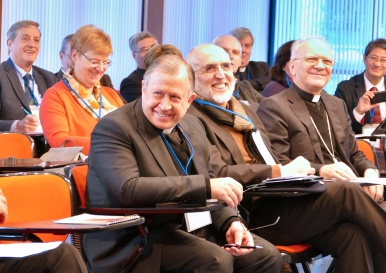
Dec 3, 2016 | Non categorizzato
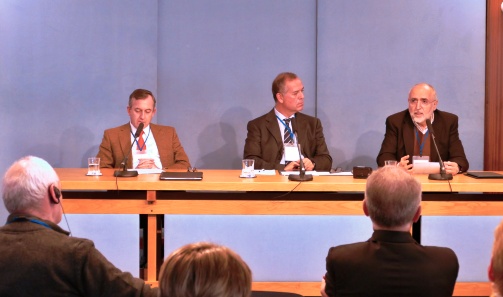
From left: Jorge López e Alberto García (Regnum Chisti), Jesús Morán (Focolari)

From left: D. Edoardo Robles Gil, General Director of the Legionaries of Christ- Regnum Christi with Jesús Morán and Archbishop Vincenzo Zani.
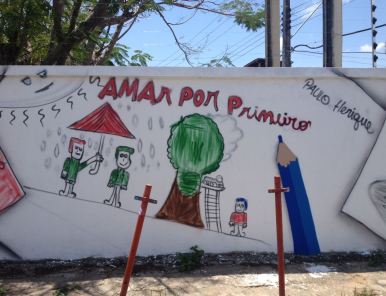
Dec 1, 2016 | Non categorizzato
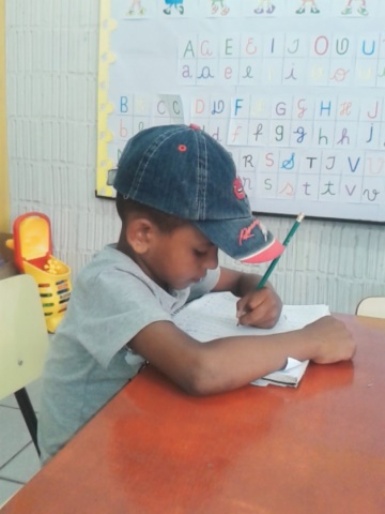 In Coroado on the outskirts of the capital of the State of Amazonas, the wall that separates and protects the centre from the harsh realities of violence and drugs that consume the neighborhood, had begun to deteriorate because of recent rains. Begun in the early 1990s through the efforts of some people from the Focolare Movement, the centre began its work in favour of social inclusion, with a nursery and primary school, but soon turned into a real social agency that was open morning until night. It was begun as an attempt to ensure children and adolescents of the area the right to a harmonious and wholesome development, through educational and recreational activities and support for their families. It is financially supoorted by the generosity of so many people, especially by distance support from the New Families Non Profit Organisation which, in addition to education also provides nutrition and preventive medical care. Several activities followed, such as a study in collaboration with the School of Educational Psychology at the Federal University of Amazonas to identify and overcome the learning problems of some of the young people. There was also also a project carried out and presented by the Pharmacy students to provide the children and their families with a basic knowledge of hygiene, nutrition and personal care. The School of Pharmacy did research project on infectious diseases with blood samples, and provided treatments. There are drug prevention programmes and programmes that combat child labour while parents are offered vocational training courses in collaboration with the Centre of Technology Education of the State of Amazonas. Jeanne and Carlos who work full time for the project recount: “Over the years we came up with Literature and Theatre workshops. We also managed to come up with a programme on emotions and sexuality for teenagers and young adults.”
In Coroado on the outskirts of the capital of the State of Amazonas, the wall that separates and protects the centre from the harsh realities of violence and drugs that consume the neighborhood, had begun to deteriorate because of recent rains. Begun in the early 1990s through the efforts of some people from the Focolare Movement, the centre began its work in favour of social inclusion, with a nursery and primary school, but soon turned into a real social agency that was open morning until night. It was begun as an attempt to ensure children and adolescents of the area the right to a harmonious and wholesome development, through educational and recreational activities and support for their families. It is financially supoorted by the generosity of so many people, especially by distance support from the New Families Non Profit Organisation which, in addition to education also provides nutrition and preventive medical care. Several activities followed, such as a study in collaboration with the School of Educational Psychology at the Federal University of Amazonas to identify and overcome the learning problems of some of the young people. There was also also a project carried out and presented by the Pharmacy students to provide the children and their families with a basic knowledge of hygiene, nutrition and personal care. The School of Pharmacy did research project on infectious diseases with blood samples, and provided treatments. There are drug prevention programmes and programmes that combat child labour while parents are offered vocational training courses in collaboration with the Centre of Technology Education of the State of Amazonas. Jeanne and Carlos who work full time for the project recount: “Over the years we came up with Literature and Theatre workshops. We also managed to come up with a programme on emotions and sexuality for teenagers and young adults.” The latest win was described by Janine and Carlos: “The economic crisis is making the situation of our country more and more difficult. For example, one institution that offered a computer course for more than ten years, had to stop collaborating with us. Some of the children’s parents are losing their jobs. And the financial resources for repairing our protective wall that had assumed a gloomy and even threatening appearance often defaced by vandals, were just not available. Then we had the idea of appealing to the Manaus Court of Justice and proposing a partnership called “Let’s paint the wall.” The proposal, which was subsequently passed, would portray in images the experience and the values that we live with the children at the Social Centre and to give an air of joy and harmony to our neighborhood. We wanted the boys and girls to be engaged in this project, so we collected their drawings so that they could be reproduced on the wall.” The newly restored and painted wall was unvieled on October 27th. “It was a very joful event for us,” say Janine and Carlos, “because this recognition from the Court of Justice not only comforts the centre and its efforts, but it allows us to bring ahead the project in the best way we can. We especially thank the many people who generously support us in giving the boys and girls the opportunity to gain knowledge and training that will allow them to take their life in their own hands and become new women and new men.” Giovanna Pieroni
The latest win was described by Janine and Carlos: “The economic crisis is making the situation of our country more and more difficult. For example, one institution that offered a computer course for more than ten years, had to stop collaborating with us. Some of the children’s parents are losing their jobs. And the financial resources for repairing our protective wall that had assumed a gloomy and even threatening appearance often defaced by vandals, were just not available. Then we had the idea of appealing to the Manaus Court of Justice and proposing a partnership called “Let’s paint the wall.” The proposal, which was subsequently passed, would portray in images the experience and the values that we live with the children at the Social Centre and to give an air of joy and harmony to our neighborhood. We wanted the boys and girls to be engaged in this project, so we collected their drawings so that they could be reproduced on the wall.” The newly restored and painted wall was unvieled on October 27th. “It was a very joful event for us,” say Janine and Carlos, “because this recognition from the Court of Justice not only comforts the centre and its efforts, but it allows us to bring ahead the project in the best way we can. We especially thank the many people who generously support us in giving the boys and girls the opportunity to gain knowledge and training that will allow them to take their life in their own hands and become new women and new men.” Giovanna Pieroni

 I attended for the first time, a classical music concert in the midst of a battle. It happened in Aleppo, where, surrounded by death, a voice of peace arose among many others that announced war, to comfort the hearts of the people and make them momentarily forget the cold and death. It was like a chapter of a modern tragedy that resembled Greek mythology. In a fully packed Church and with very few tools, Father Elias Janji with the Naregatsi choir and the pianist played some pieces of Verdi, Mozart, Vivaldi and Karl Orf, elevating our spirits to another horizon, despite the polar chill that has invaded Aleppo these days.. And to think that not too far away, the tragedy continues with missiles launched from Eastern Aleppo over the Western zone, killing school children and innocent people, while in the Eastern part of the city, the Syrian army continues to attack. Thousands of people (an estimated 60,000 up to today) managed to escape from East Aleppo and take refuge in the Western zone. They tell of how many have been taken as hostages and that some of those who were shot in their backs while escaping, were killed. Others escaped amid the gunfire, carrying their grandmas or other elderly relatives on their shoulders. The people were relieved since they could finally return to their own homes that were liberated in these days while the army took hold of the city’s water pumping station, even if it was mined. Water is forecasted to return to the city in a month’s time, after the technicians have completed their work. Thus a chapter of the tragedy will end, though there will surely be many more.
I attended for the first time, a classical music concert in the midst of a battle. It happened in Aleppo, where, surrounded by death, a voice of peace arose among many others that announced war, to comfort the hearts of the people and make them momentarily forget the cold and death. It was like a chapter of a modern tragedy that resembled Greek mythology. In a fully packed Church and with very few tools, Father Elias Janji with the Naregatsi choir and the pianist played some pieces of Verdi, Mozart, Vivaldi and Karl Orf, elevating our spirits to another horizon, despite the polar chill that has invaded Aleppo these days.. And to think that not too far away, the tragedy continues with missiles launched from Eastern Aleppo over the Western zone, killing school children and innocent people, while in the Eastern part of the city, the Syrian army continues to attack. Thousands of people (an estimated 60,000 up to today) managed to escape from East Aleppo and take refuge in the Western zone. They tell of how many have been taken as hostages and that some of those who were shot in their backs while escaping, were killed. Others escaped amid the gunfire, carrying their grandmas or other elderly relatives on their shoulders. The people were relieved since they could finally return to their own homes that were liberated in these days while the army took hold of the city’s water pumping station, even if it was mined. Water is forecasted to return to the city in a month’s time, after the technicians have completed their work. Thus a chapter of the tragedy will end, though there will surely be many more.  December 4 is the feast of St. Barbara, the young girl martyred in the first centuries of Christianity, pierced with a sword by her father since, as a follower of Jesus, she had refused to adore another God. It is a great feast for the Christians of the East, adults and children who, despite the war, gathered together to honour her in a masquerade and recount her story in song – a story which despite the centuries passed – has not changed very much. We can’t help but wonder, what has remained of man and his dignity? What will happen now? Will the war in Aleppo end, and bring back serenity to the people who have suffered so much, even if they will find a great part of the city destroyed? The population is weary and wants the conflict to end. But the armed groups refuse to accept defeat and want to fight to the last, despite the appeal of the UN special envoy, Staffan De Mistura, to all the groups to leave the city and spare the lives of the people, who would otherwise pay a heavy price, according to the logic of war! How can we forget that in the end, it is Man since each one, whether good or bad, is an image of God, though this image is buried under a thousand vices and wickedness. With Christmas now at our doorstep, let us therefore remind ourselves that this feast should not only be a remembrance of a past fact celebrated with the usual festivity. The arrival of the “Prince of Peace” should also change the hearts and gestures of all of us, because these become tiny stones in the construction of a better world we all dream of. From Aleppo, Pascal Bedros
December 4 is the feast of St. Barbara, the young girl martyred in the first centuries of Christianity, pierced with a sword by her father since, as a follower of Jesus, she had refused to adore another God. It is a great feast for the Christians of the East, adults and children who, despite the war, gathered together to honour her in a masquerade and recount her story in song – a story which despite the centuries passed – has not changed very much. We can’t help but wonder, what has remained of man and his dignity? What will happen now? Will the war in Aleppo end, and bring back serenity to the people who have suffered so much, even if they will find a great part of the city destroyed? The population is weary and wants the conflict to end. But the armed groups refuse to accept defeat and want to fight to the last, despite the appeal of the UN special envoy, Staffan De Mistura, to all the groups to leave the city and spare the lives of the people, who would otherwise pay a heavy price, according to the logic of war! How can we forget that in the end, it is Man since each one, whether good or bad, is an image of God, though this image is buried under a thousand vices and wickedness. With Christmas now at our doorstep, let us therefore remind ourselves that this feast should not only be a remembrance of a past fact celebrated with the usual festivity. The arrival of the “Prince of Peace” should also change the hearts and gestures of all of us, because these become tiny stones in the construction of a better world we all dream of. From Aleppo, Pascal Bedros 





